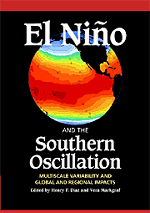Book contents
- Frontmatter
- Contents
- Contributors
- Acknowledgments
- Preface
- SECTION A Global and Regional Characteristics and Impacts of ENSO Variability
- SECTION B Long-Term Changes in ENSO: Historical, Paleoclimatic, and Theoretical Aspects
- 7 The Documented Historical Record of El Niño Events in Peru: An Update of the Quinn Record (Sixteenth through Nineteenth Centuries)
- 8 Tree-Ring Records of Past ENSO Variability and Forcing
- 9 The Tropical Ice Core Record of ENSO
- 10 Long-Term Variability in the El Niño/Southern Oscillation and Associated Teleconnections
- 11 Modulation of ENSO Variability on Decadal and Longer Timescales
- 12 Global Climate Change and El Niño: A Theoretical Framework
- 13 The Past ENSO Record: A Synthesis
- Index
7 - The Documented Historical Record of El Niño Events in Peru: An Update of the Quinn Record (Sixteenth through Nineteenth Centuries)
from SECTION B - Long-Term Changes in ENSO: Historical, Paleoclimatic, and Theoretical Aspects
Published online by Cambridge University Press: 04 August 2010
- Frontmatter
- Contents
- Contributors
- Acknowledgments
- Preface
- SECTION A Global and Regional Characteristics and Impacts of ENSO Variability
- SECTION B Long-Term Changes in ENSO: Historical, Paleoclimatic, and Theoretical Aspects
- 7 The Documented Historical Record of El Niño Events in Peru: An Update of the Quinn Record (Sixteenth through Nineteenth Centuries)
- 8 Tree-Ring Records of Past ENSO Variability and Forcing
- 9 The Tropical Ice Core Record of ENSO
- 10 Long-Term Variability in the El Niño/Southern Oscillation and Associated Teleconnections
- 11 Modulation of ENSO Variability on Decadal and Longer Timescales
- 12 Global Climate Change and El Niño: A Theoretical Framework
- 13 The Past ENSO Record: A Synthesis
- Index
Summary
Abstract
The áclassical chronology of El Niño events for the past four and a half centuries proposed by Quinn et al. (1987) was primarily based upon indications of anomalous meteorological and hydrological phenomena observed in Peru and neighboring areas, as described by various authors and anonymous sources. This sequence of reconstructed El Niño events, later improved and modified by Quinn (1992, 1993; Quinn and Neal 1992), became the major reference for proxy calibrations and for most studies on climate variability related to El Niño/Southern Oscillation (ENSO) during historical, pre-instrumental, times. Precisely because global and regional records of interannual climate variability are becoming more diversified and accurate, there is an urgent need to reevaluate and consolidate the documentary record of El Niño manifestations, particularly in southwestern South America, a key area for ENSO studies.
A preliminary revision of some of the sources used by Quinn et al. (1987) to elaborate on their record (Hocquenghem and Ortlieb 1992b) showed that some of the El Niño events were actually poorly documented and simply may not have occurred. For instance, some events had been reconstructed exclusively from evidence of Rímac River floods at Lima, while no clear relationship has been established between these floods and ENSO manifestations. Another question concerns the significance of anomalous rains in southern Peru: Do they correspond to El Niño situations, as inferred by Quinn et al., or rather to conditions associated with the opposite phase of the Southern Oscillation (La Niña)? Furthermore, a previous analysis of documentary sources on rainfall excess in central Chile during the sixteenth through nineteenth centuries (Ortlieb 1994) revealed many discrepancies with respect to the regional El Niño record of Quinn.
- Type
- Chapter
- Information
- El Niño and the Southern OscillationMultiscale Variability and Global and Regional Impacts, pp. 207 - 296Publisher: Cambridge University PressPrint publication year: 2000
- 23
- Cited by



